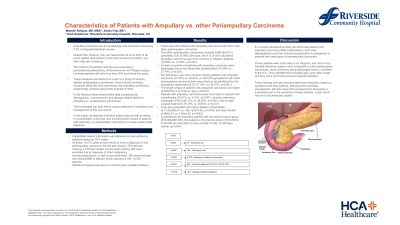Back


Poster Session D - Tuesday Morning
Category: Biliary/Pancreas
D0022 - Characteristics of Patients With Ampullary vs. Other Periampullary Carcinoma
Tuesday, October 25, 2022
10:00 AM – 12:00 PM ET
Location: Crown Ballroom

Has Audio
- MB
Mahesh Botejue, MD
HCA Healthcare, Riverside Community Hospital
Riverside, CA
Presenting Author(s)
Mahesh Botejue, MD1, Samia Faiz, MD2
1HCA Healthcare, Riverside Community Hospital, Riverside, CA; 2Riverside Community Hospital, Riverside, CA
Introduction: Ampullary carcinoma (AC) are a rare neoplasia comprising 0.2% of all gastrointestinal cancers. Despite this, they are responsible for up to 20% of all tumor related obstructions of the common bile duct (CBD), and their rates are increasing. These neoplasia are distinct but a part of a group of cancers labeled periampullary carcinoma (PC), which consist of primary duodenal, distal bile duct, pancreatic and ACs anatomically centered around the Ampulla of Vater. Here we describe individual patient data as well as trends in comorbidities, outcomes, and socioeconomic factors in patients with AC vs. PC in a large system-wide database.
Methods: Deidentified patient information was obtained via data gathering software based on CPT codes. Of these, 16075 patients were found to have a diagnosis of one periampullary carcinoma. 5599 were removed due to lack of data, leaving us with 10476 patients. Statistical analysis was done on commercially available software.
Results: There were 245 patients with AC and 10231 with other PC. Other PC included 9199 (89.91%) pancreatic, 620 (6.06%) bile duct, and 412 (4.03%) duodenal. AC was more common in Hispanic patients (19.59% vs. 13.08%, p< 0.001). More patients with AC were discharged home than those with periampullary (74.29% vs. 57.79%, p< 0.001). ICU admission was more common among patients with AC (37.55% vs. 28.92%, p=.004). Patients with other PC were more likely to be admitted from the ED (77.19% vs. 58.37%, p< 0.001). The length of stay of patients with AC was higher (8.45±8.59 vs. 6.17±6.41 days, p< 0.001).
Patients with AC were more likely to present with cholelithiasis (15.51% vs. 6.16%, p< 0.001), primary sclerosing cholangitis (PSC) (46.12% vs. 28.25%, p< 0.001), and to seek surgical treatment (79.18% vs. 49.94%, p< 0.001). They also presented with higher ALP (4.11.42±365.51 vs. 339.12±378.55, p=0.004) and total bilirubin (4.69±6.21 vs. 3.40±4.50, p=0.002). Compared to AC patients with the lowest income ($19,000-$50,000), the patients in the income group $70,000 to $100,000 had a length of stay 10.328 days shorter (p=0.044)
Discussion: In our large retrospective study we show that patients with AC differ in both demographics and clinical characteristics compared to patients with other types of PC. These findings will help clinicians tailor their evaluation and allow more individualized management. We also show that socioeconomic level plays a substantial part in the outcomes of these patients, a topic which has yet to be previously studied.

Disclosures:
Mahesh Botejue, MD1, Samia Faiz, MD2. D0022 - Characteristics of Patients With Ampullary vs. Other Periampullary Carcinoma, ACG 2022 Annual Scientific Meeting Abstracts. Charlotte, NC: American College of Gastroenterology.
1HCA Healthcare, Riverside Community Hospital, Riverside, CA; 2Riverside Community Hospital, Riverside, CA
Introduction: Ampullary carcinoma (AC) are a rare neoplasia comprising 0.2% of all gastrointestinal cancers. Despite this, they are responsible for up to 20% of all tumor related obstructions of the common bile duct (CBD), and their rates are increasing. These neoplasia are distinct but a part of a group of cancers labeled periampullary carcinoma (PC), which consist of primary duodenal, distal bile duct, pancreatic and ACs anatomically centered around the Ampulla of Vater. Here we describe individual patient data as well as trends in comorbidities, outcomes, and socioeconomic factors in patients with AC vs. PC in a large system-wide database.
Methods: Deidentified patient information was obtained via data gathering software based on CPT codes. Of these, 16075 patients were found to have a diagnosis of one periampullary carcinoma. 5599 were removed due to lack of data, leaving us with 10476 patients. Statistical analysis was done on commercially available software.
Results: There were 245 patients with AC and 10231 with other PC. Other PC included 9199 (89.91%) pancreatic, 620 (6.06%) bile duct, and 412 (4.03%) duodenal. AC was more common in Hispanic patients (19.59% vs. 13.08%, p< 0.001). More patients with AC were discharged home than those with periampullary (74.29% vs. 57.79%, p< 0.001). ICU admission was more common among patients with AC (37.55% vs. 28.92%, p=.004). Patients with other PC were more likely to be admitted from the ED (77.19% vs. 58.37%, p< 0.001). The length of stay of patients with AC was higher (8.45±8.59 vs. 6.17±6.41 days, p< 0.001).
Patients with AC were more likely to present with cholelithiasis (15.51% vs. 6.16%, p< 0.001), primary sclerosing cholangitis (PSC) (46.12% vs. 28.25%, p< 0.001), and to seek surgical treatment (79.18% vs. 49.94%, p< 0.001). They also presented with higher ALP (4.11.42±365.51 vs. 339.12±378.55, p=0.004) and total bilirubin (4.69±6.21 vs. 3.40±4.50, p=0.002). Compared to AC patients with the lowest income ($19,000-$50,000), the patients in the income group $70,000 to $100,000 had a length of stay 10.328 days shorter (p=0.044)
Discussion: In our large retrospective study we show that patients with AC differ in both demographics and clinical characteristics compared to patients with other types of PC. These findings will help clinicians tailor their evaluation and allow more individualized management. We also show that socioeconomic level plays a substantial part in the outcomes of these patients, a topic which has yet to be previously studied.
Disclosures:
Mahesh Botejue indicated no relevant financial relationships.
Samia Faiz indicated no relevant financial relationships.
Mahesh Botejue, MD1, Samia Faiz, MD2. D0022 - Characteristics of Patients With Ampullary vs. Other Periampullary Carcinoma, ACG 2022 Annual Scientific Meeting Abstracts. Charlotte, NC: American College of Gastroenterology.
